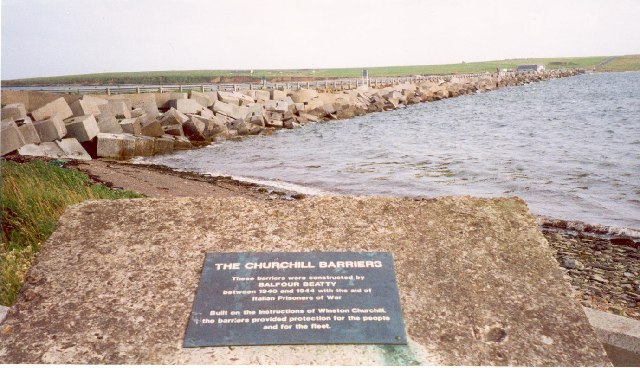Churchill barriers

|
| This is the view from the Orkney mainland looking at Churchill barrier number one. This causeway allows drivers to travel over to the island of Lamb Holm. |
Contents |
[edit] Introduction
The Churchill barriers were four solid causeways in Orkney constructed during the Second World War. The barriers were used as a defensive measure to prevent enemy ships and submarines from entering Scapa Flow, which housed the bulk of Britain’s fleet at the time.
The move was ordered by Prime Minister Winston Churchill in response to the sinking of the HMS Royal Oak in Scapa Bay in October 1939. The attack by a German submarine - which had been able to evade the ineffective submarine defences in place at the time - killed 835 soldiers.
[edit] Construction
The scheme to build the barriers was designed and supervised by Sir Arthur Whitaker, Civil Engineer-in-Chief of the Admiralty. The contractors were Balfour Beatty & Co Ltd. Italian prisoners of war who were interned at Lamb Holm formed part of the workforce that made the concrete blocks and built the structure.
Building long fixed barriers across bodies of tidal water presented unusual engineering requirements in the mid-20th century. In this period, solid causeways were not a normal response to civilian transport needs, with bridges or ferries usually preferred when open water had to be crossed. The barriers’ designers had to take account of the fast flowing tidal water in narrow, but relatively deep channels. The barriers were designed to withstand a 4-5 knot tidal current.
The barriers were ingenious in their construction. Built using bolsters, these wire cages or baskets were filled with broken rock and then dropped into the water of the channel.
Most of this deep structure is underwater. A road carriageway formed from dumped aggregate and horizontally laid concrete blocks overlies the causeway base. In total, all four barriers required about 250,000 tons of stone rubble and 66,000 concrete blocks.
[edit] Protected status
The barriers provide a vital road link from the Orkney mainland to South Ronaldsay.
In November 2016, two of the four barriers were listed at Category A - the highest status - by Historic Environment Scotland. This means that they are recognised as being of national or international importance. Only around 8% of Scotland’s 47,000 listed buildings are recognised in this category.
The two listed structures are Churchill barrier number three (which links Glimps Holm and Burray and number four (which links Burray and South Ronaldsay). Historic Environment Scotland did not consider it appropriate to list barriers one and two due to proposed bridge developments because of structural integrity issues caused by rising sea levels.
Despite their significance and protected status, the barriers face flood risk and require preservation.
[edit] Related articles on Designing Buildings Wiki
- An art deco cinema on wartime Orkney.
- A review of Scotland's historic lighthouses.
- Bletchley Park restoration.
- Causeway.
- Hesco barrier.
- Historic Environment Scotland - 12 new commemorative plaques.
- Maunsell forts.
- Second world war heritage at sea.
- Seven projects receive Historic Environment Scotland funding.
IHBC NewsBlog
Images from inside a Grade II listed hotel show the scale of its collapse
The Corbett Arms in Tywyn has fallen into serious disrepair.
Old Sarum fire in listed (& disputed) WW1 Hangar - Wiltshire Council has sought legal advice after fire engulfed a listed First World War hangar that was embroiled in a lengthy planning dispute.
UK Antarctic Heritage Trust launches ‘Virtual Visit’ website area
The Trust calls on people to 'Immerse yourself in our heritage – Making Antarctica Accessible'
Southend Council pledge to force Kursaal owners to maintain building
The Council has pledged to use ‘every tool in the toolbox’ if urgent repairs are not carried out.
HE’s Research Magazine publishes a major study of the heritage of England’s suburbs
The article traces the long evolution of an internal programme to research 200 years of suburban growth
IHBC Context 183 Wellbeing and Heritage published
The issue explores issues at the intersection of heritage and wellbeing.
SAVE celebrates 50 years of campaigning 1975-2025
SAVE Britain’s Heritage has announced events across the country to celebrate bringing new life to remarkable buildings.
IHBC Annual School 2025 - Shrewsbury 12-14 June
Themed Heritage in Context – Value: Plan: Change, join in-person or online.
200th Anniversary Celebration of the Modern Railway Planned
The Stockton & Darlington Railway opened on September 27, 1825.
Competence Framework Launched for Sustainability in the Built Environment
The Construction Industry Council (CIC) and the Edge have jointly published the framework.













